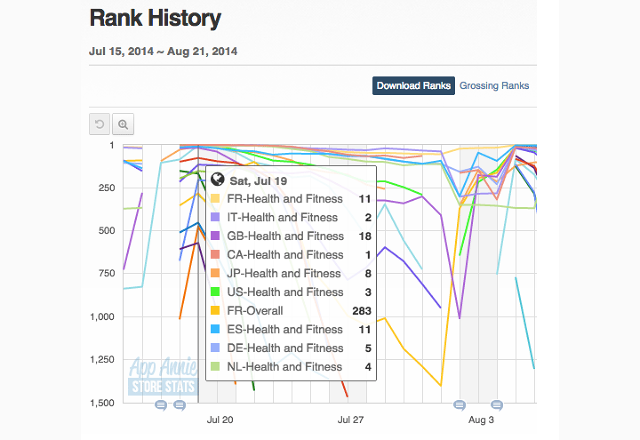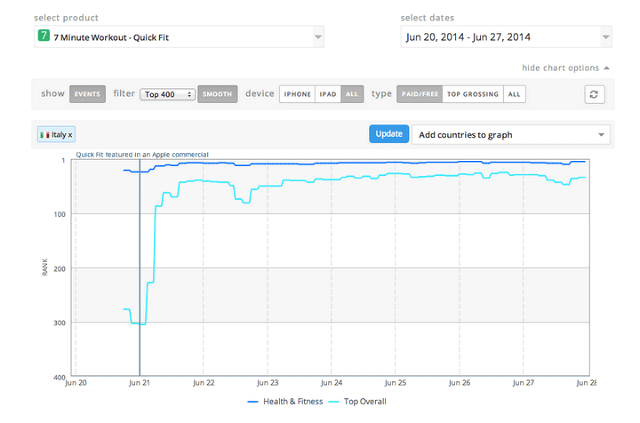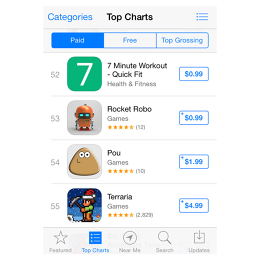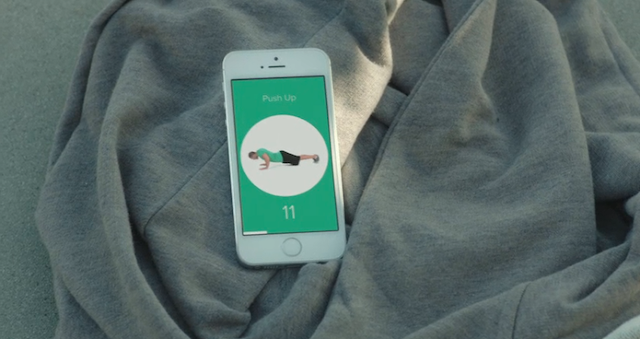fastcompany.com
LANDING A FEW SECONDS OF AIRTIME IN AN INTERNATIONAL APPLE SPOT, IT TURNS OUT, ISN'T SIMPLY A MATTER OF LUCK.
Apple ads are some of the most iconic pieces of television ever made. The "Mac Vs. PC" ads, the Steve Jobs-mandated "Think Different" campaign, and the "There’s an app for that" iPhone commercials are now part of computer marketing lore. The recent "Misunderstood" campaign won the company an Emmy, and the "1984" Super Bowl spot may be the most famous television ad ever.
More recently, Apple has taken a more literal approach to marketing, using its ads to showcase iOS apps as they work in the real world. One batch that aired last year, called "You’re more powerful than you think," highlighted apps meant to give iPhone users a kind of superpower, each related to one of four themes: power, parenthood, dreams, and strength. My app, 7 Minute Workout: Quick Fit, was included in the last category.
Seeing it on television—when it debuted in Europe, during the freaking World Cup, in front of millions of viewers—was absolutely shocking. But it was also gratifying, because, as it turns out, being in an Apple ad isn't just a matter of luck.
THE EMAIL
It all began when I received an email out of the blue back in March from Apple’s outside ad agency, TBWA\Media Arts (the company now has its own in-house agency too). They wanted me to know that our app was being considered for a broadcast commercial. Their team was still working on the creative ideas, and told us there were no guarantees we'd make the final spot. I signed the required paperwork and then tried really hard not to think about this or get my hopes up for the next couple of months.

Two months later, another email arrived. This time it was a contract request from the Screen Actors Guild (SAG). Our app features a series of short workout videos. If they were to be included in the ad, Apple would need to pay residuals to the fitness trainer/model we worked with. I quickly got ahold of Christian so he could sign off on the final documents. Then it was back to the waiting game.
I heard back once more regarding an app-specific issue that needed to be resolved. But I knew nothing was guaranteed. And then silence. I tried really hard not to think about it.
Then word arrived in my email box: Our app had made the international spot. I let out a huge sigh of relief. And then, of course, more waiting. I and the rest of our team at Tiny Hearts would wait another agonizing two weeks.
I don't subscribe to the European channels where the ad debuted, but I managed to watch it online that night in Toronto. As the international spot blazed across Europe and the Internet, I watched tech blogs light up and the ad take off. It was like riding an exhilarating, insane roller coaster (but a really elegant one designed in Cupertino).
It turns out that 30 seconds of ad time during the World Cup can cost up to $1 million. That, of course, is not something an independent app studio like ours could afford. And then there was all the other stuff that wasn't on TV: the "You’re more powerful than you think" campaign was promoted heavily on Apple's websites with additional details and links to all of the apps featured in the ad. The ad and its apps were also prominently showcased on the App Store with a special category that included direct links to the apps. This special category most likely led to the most downloads for us.

How did we do? The ad first aired in Italy and France, so I’ll focus on those two regions first (we saw a similar spike in other international markets that followed, like Belgium and Germany).
Before the ad hit, Quick Fit wasn’t even ranking in the top 400 Health & Fitness apps in Italy, let alone the top overall paid list. But that changed around the evening of June 20. We watched as Quick Fit climbed the top overall charts literally overnight, peaking at 26th overall and top 5 in the Health & Fitness category in Italy.

We saw the same steep spike in France a few days later, where it peaked at 19th overall and 5th in Health & Fitness.

These European countries started bringing in more revenue than the U.S., which until then had been our largest market. We also noticed we were getting more positive reviews in these areas thanks to the increased visibility.
But what goes up the app charts must come back down. Our app wasn't immune to this basic law of the App Store. To preempt this, we ran a couple of promotions in July: First, we made Quick Fit free for a few days as a way to boost usage and word of mouth. We promoted the free sale through large review sites like AppAdvice andTUAW. (We ended up being featured on sites like Lifehacker, Laughing Squid, andSwissmiss.) In August, we followed up the free promotion with a sale: We offered the app for $0.99 with all of the workouts, down from $6.99. Our goal was to get back in the top paid list.

It worked. One month after the ad aired, thousands of people sent Quick Fit back into the top charts. It managed to actually get higher in the U.S. charts than it had before.
After the ad aired, we noticed we were getting more inbound press requests. A few weeks later, we heard from Fleur Britten, a journalist for the Sunday Times. She had been hearing a lot about our quick fitness app, and wanted to feature it in an upcoming Sunday Times Magazine fitness feature.
The power of that mainstream media mention propelled Quick Fit into the top 10 overall in the U.K. We also did some outreach, and noticed that getting featured in an Apple ad made it a lot easier to get media attention.
Some Non-Surefire Ways To Get On Apple's Radar
How did we end up with an Apple ad to begin with? I think it's virtually impossible to plan for something like that. But I do think there were a few key factors that increased our chances of being selected.

MAKE FEATURE-WORTHY PRODUCTS
First and foremost, aim to make products that are worthy of being featured. For us, getting featured on the App Store was the precursor to getting featured in a TV ad. My best guess is that the App Store's editorial team and ad agency work closely together to find the perfect apps to highlight in campaigns. So focus on the basics: creating a great user experience and obsessively focusing on designing something unique enough to help you stand out from the crowd and capture the attention of your customers, the press, and Apple’s editors. In short, make something people love. If you don't, then you probably have better things to do than trying to end up in an Apple ad.
BE TIMELY AND RELEVANT
Being at the right place at the right time is generally hard to predict, but that doesn’t mean it’s completely out of your control. Our app was the result of solving a problem that I had: not having enough time to work out. This also happens to be the number-one excuse most people give for not getting off their butts. Its central idea—quick, high-intensity workouts that you can do anywhere without any equipment—was one that the New York Times' "Well" blog popularized in a 2013 blog post on "The Scientific 7-Minute Workout." We took the concept further by creating original routines that included a seven-minute ab workout, a fifteen-minute yoga practice, and a four-minute tabata routine. This was one way we differentiated ourselves from all of the other seven-minute workout apps.

BE CONSISTENT AND MAINTAIN QUALITY
Let’s be realistic: Making apps is really hard. If you don’t love it, you’re not going to have the stamina to continue to excel and improve your craft. The fact that most apps don’t make sustainable revenue doesn’t help. It’s the developers and studios that survive that end up thriving on the store, the ones that continually ship quality products. There are thousands of subpar zombie apps on the App Store from folks who tried and gave up. Apple states in its review guidelines:
If your App looks like it was cobbled together in a few days, or you're trying to get your first practice App into the store to impress your friends, please brace yourself for rejection. We have lots of serious developers who don't want their quality Apps to be surrounded by amateur hour.
Take your apps seriously and treat it as a craft. One that you continually work to refine until you are at a point where you can consistently ship great work.
LOCALIZE YOUR APP
One of the best decisions we made early on was to support multiple languages with Quick Fit and Wake Alarm. We focused on the key regions Apple recommends in its internationalization guidelines. Apps are a global phenomenon with millions of non-English-speaking users. We didn’t want to limit our goal of helping people get fit to just English speakers, so we localized our app's interface, description, and even screenshots.
Like other aspects of our development and design, localizing our app was a tedious process, but it helped boost our position in the charts, secure a prominent feature in those countries, and eventually—maybe—land a role in a TV commercial seen by people we never imagined we'd reach.
No comments:
Post a Comment